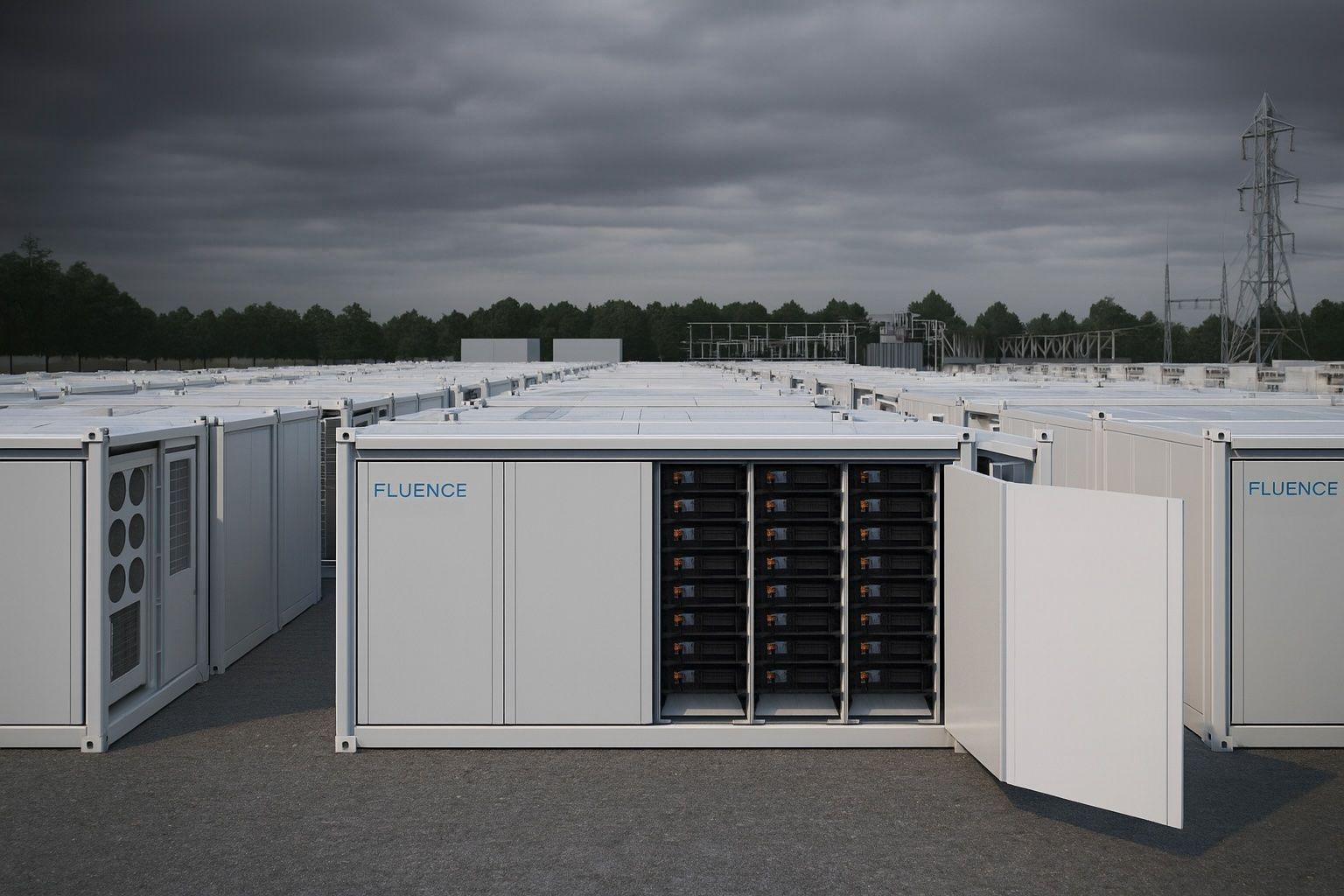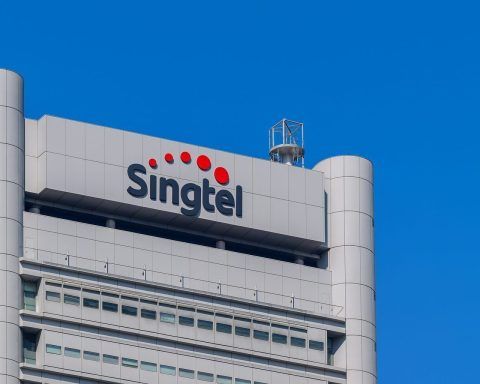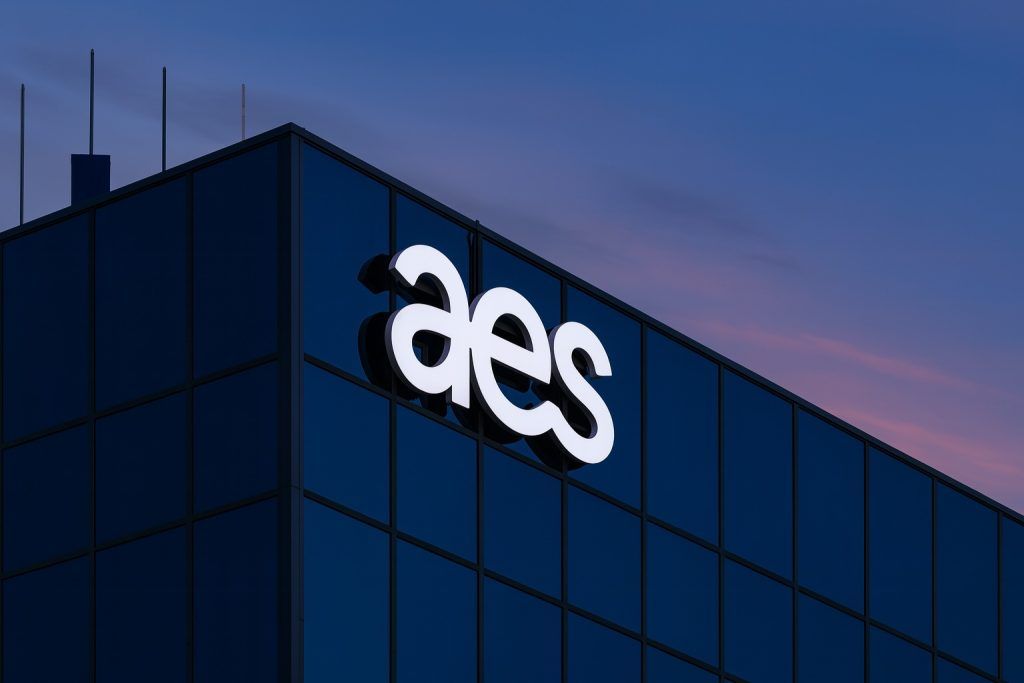- Recent Stock Surge: FLNC jumped ~11% on Oct 1, 2025 (to ~$12.03) after two-week gains from around $6 to $12, far above its 50-day (~$8.3) and 200-day (~$6.4) moving averages [1] [2]. Volatility is high (beta ~2.66) and short interest remains significant.
- Analyst Sentiment: Consensus is a Hold (17 holds, 4 buys, 3 sells) with an average 1-year price target ~$8.13 [3]. Most targets were trimmed in Aug/Sep 2025 (e.g. Barclays to $8, RBC to $7) despite the recent rally [4] [5].
- Financial Snapshot (Q3 ’25): Q3 revenue ~$602.7M (+24.7% YoY) [6], beating EPS to $0.01 (vs. –$0.02 est). Net income ~$6.9M [7]. Cash ~$460M with total liquidity ~$903M (including credit lines) [8]. FY2025 guidance was cut to $2.6–2.8B (from $3.1–3.7B) due to project delays [9] [10].
- Balance Sheet: As of Q3 2025, debt/equity ~0.75, current ratio ~1.64, quick ratio ~1.06 [11]. In Dec 2024, Fluence raised $400M convertible notes (2.25% due 2030) to fund expansion [12].
- Backlog & Pipeline: Backlog remains robust (~$4.9B at June 2025) with $508.8M new Q3 orders, plus $1.1B added in Jul–Aug [13]. Management expects ~$2.5B of backlog will convert to revenue in FY2026 [14]. Global project pipeline ~ $23.5B (47% in Americas) [15].
- Major News (Sept 2025): Secured a 133 MW / 622 MWh Polish grid storage contract (DTEK’s Trzebinia project) using its Smartstack™ systems [16] [17]. Also completed a 200 MW/400 MWh storage deployment in Ukraine for DTEK [18]. Opened a 35 GWh automated battery plant in Vietnam (Gridstack Pro & Smartstack) [19]. Announced first U.S.-made Gridstack Pro units (supports domestic supply chain and tax credits) [20].
- Industry Trends: Renewables and storage are booming: global battery storage capacity is forecast to ~411 GW by 2030 (15× 2021 levels) [21]. IEA predicts renewables will be the world’s top power source by 2026 [22]. Battery costs have fallen ~90% since 2010 [23], fueling $50+ B invested in storage in 2024 [24]. Fluence benefits from U.S. IRA and EU clean-energy policies boosting grid-storage demand.
- Competition: Key competitors include Tesla Energy (Megapack/Powerwall) – Tesla had ~14.7 GWh storage output in 2023 [25] – and large-scale integrators like GE (Atlas Storage), Enphase (residential/storage), LG/CATL (battery cells), Panasonic (batteries), and legacy utilities (AES, Siemens). AES, Fluence’s JV parent, notes ~50% of its new projects now include battery storage [26]. Wood Mackenzie ranked Fluence #2 (2022) and #3 (2023) among global BESS integrators (behind Sungrow and Tesla) [27]. Fluence’s key strengths are its modular “Stack” technology (Gridstack, Smartstack), strong backlog, and Siemens/AES backing, while competition focuses on scale or specific segments.
Stock Performance and Valuation
FLNC has been highly volatile. After collapsing to ~$4 in early 2025 on revenue misses and short-seller claims, the stock exploded in mid-Sep. News of major BESS contracts (e.g. Ukraine, Poland) and AI-driven grid demand speculation (e.g. data center needs) fueled a ~70–80% rally into early Oct [28] [29]. On Oct 1 it closed ~$12, up ~11% that day on ~3.7M shares (vs. avg ~5M) [30] [31]. FLNC now trades well above its 50-day (~$8.3) and 200-day (~$6.4) moving averages [32], and recent RSI/MACD indicators (not shown) suggest overbought conditions.
Despite the surge, analyst targets remain muted (avg ~$8.1) [33] [34]. Valuation multiples are strained: FLNC posted a tiny GAAP profit only in Q3, so TTM earnings are still negative (P/E –57) [35]. Enterprise value (~$2.4B) against $903M liquidity implies high EV/sales (~1× FY2025 revenues). By comparison, larger battery peers trade 1–2× sales despite profitability (e.g. Tesla Energy division). In summary, momentum is bullish, but fundamental valuation is historically rich; most analysts rate it a “Hold” [36] [37].
Financial Health
Fluence’s top-line is rebounding, but profits lag. Key recent figures: Q1’25 (Dec ’24) revenue ~$186.8M (–49% YoY) and loss $57.0M [38], Q2’25 (Mar ’25) rev ~$431.6M (–31%) loss $41.9M [39], and Q3’25 (Jun ’25) rev ~$602.5M (+24.7% YOY) net profit ~$6.9M [40]. The swing to profit reflects improved execution and tariff easing (see below). Gross margins have been modest (~13%) [41].
Guidance for FY2025 was cut to $2.6–2.8B as Fluence shifted ~ $100M of projects into FY2026 [42] [43]. Management notes this is temporary – many projects simply delayed by tariffs/manufacturing ramp-ups [44] [45]. Backlog conversion is expected to drive FY2026 growth. In fact, analysts model revenues jumping to ~$3.25B in FY2026 (≃+22% YoY) [46]. Adjusted EBITDA is slated to be low (guide midpoint ~$10M for FY2025 [47]) due to project ramp costs, but should grow as volumes increase.
Liquidity is strong: cash (~$460M in Q3) plus $400M new convertible notes (2024) and a $150M supply-chain facility [48]. Total liquidity ~+$903M [49], giving flexibility. Debt is limited (no significant senior debt besides conv. notes). Balance sheet ratios are healthy (current ratio ~1.64, quick ~1.06 [50]). However, the firm has no large reserves – nearly all capital is already raised for expansion – so further growth funding might require equity or partnerships.
Recent News & Developments
Late Sep 2025 was a busy period: On Sept 22 Fluence won a 133 MW/622 MWh contract for DTEK/DRI’s Trzebinia energy storage project in Poland [51] [52]. This will be the largest BESS in Poland’s capacity market, using Fluence’s compact Smartstack™ modules. DTEK’s CEO hailed Fluence as a “global market leader” [53]. Fluence’s Julian Jansen noted Poland could become “one of the five largest European [storage] markets by 2030” and pledged further investment in Polish operations [54]. This news alone accounted for a big jump in FLNC late Sept.
Earlier, Fluence activated its first major U.S. manufacturing milestone: on Sept 12 it delivered the first domestically-made Gridstack Pro systems [55]. President (Americas) John Zahurancik said this proves the U.S. “can again be a leader in battery storage manufacturing” and that US-built systems help qualify for new IRA incentives [56]. Supply-chain head Peter Williams added that reshoring enhances long-term reliability [57]. This aligns with Fluence’s broader onshoring: it already opened a 35 GWh plant in Vietnam (Aug) [58] and has built U.S. module and pack factories.
Other recent headlines include DTEK’s U.S. subsidiary energizing a 200 MW (400 MWh) grid storage portfolio in Ukraine using Fluence systems [59], and ongoing expansions (e.g. services partnerships in Asia). Notably, on Sept 9 Fluence announced it has begun manufacturing its next-gen Smartstack units (in Vietnam) [60]. Investor scrutiny also lingered: the company confirmed an SEC investigation (opened Aug 2024) is ongoing but “unlikely to materially” alter results [61].
Expert Opinions
Fluence management strikes an optimistic tone. CEO Julian Nebreda stated “the fundamentals of our business remain incredibly strong, supported by a robust backlog” and noted new orders should bolster FY2026 sales [62]. CFO Ahmed Pasha echoed confidence: he highlighted a $2.5B backlog already in place for FY2026 and said contracting activity (paused by U.S. tariff uncertainty) is “beginning to return” as duties were cut [63] [64]. Fluence leadership also credits recent U.S. policy (IRA) for reviving storage demand.
Analysts and industry watchers are more cautious. Most sell-side firms rate FLNC a hold/neutral on valuation and short-term execution risks [65] [66]. They note mid-term upside from global storage growth, but near-term strains: Barclays and UBS recently reiterated “Hold” with ~8–9 price targets [67]. Evercore and Wolfe (earlier in 2025) cut estimates on slower ramp-up. A Wood Mackenzie analysis points out Fluence slipped to #3 integrator (2023) and warns supply-chain and policy factors have “impaired near-term sales” [68].
On the bright side, industry voices emphasize the massive demand tailwind. The World Economic Forum reports battery storage investment topped $50B in 2024 [69] and notes AI and EV growth will drive new storage projects [70]. In that context, Fluence’s CEO contends long-term outlook is intact despite short-term noise (commenting that tariff-driven margin pressures are “temporary” and contracts are being re-priced) [71]. Overall, experts see Fluence positioned for growth if it can execute its backlog, but caution that high expectations are already priced in.
Outlook & Forecasts
Short-term, analysts expect continued headwinds from project delays and cautious government spending. FLNC’s one-year consensus price target (~$8–9) implies downside vs. today’s price [72] [73]. Estimates for FY2025/EPS range around –$0.26 (loss) [74], reflecting Q4 execution drag. For FY2026, revenue forecasts jump ~+22% to ~$3.25B [75] as delayed orders recognize, and EPS losses narrow to a few cents [76]. If Fluence hits the “low end” of FY2025 revenue ($2.6B) as guided, that implies ~80% of original 2025 plan delivered on time, with the rest pushed to FY2026.
Longer-term, the clean-energy transition portends growth. BloombergNEF sees ~400+ GW of stationary storage installed by 2030 [77]. Fluence is targeting ~50 markets and touts gigawatts contracted. At the Oct 2025 pace, backlog conversion could power low-double-digit revenue growth in 2026–27 (subject to policy stability). The Biden administration’s 2030 targets (50% renewable grid) and EU reforms support large-grid storage. However, execution risk remains: if manufacturing hiccups or tariff flare-ups recur, timelines slip. Most professionals we surveyed view FLNC as a “buy” only for contrarians who trust the long-term thesis; otherwise it’s a neutral to underperform given current valuation.
Industry Context
The broader renewable and storage market is booming. The IEA and Carbon Brief report that renewables will outpace coal by ~2026 [78], driven by wind/solar installations. But grids need flexibility – hence massive investment in batteries. The International Renewable Energy Agency notes battery costs plunged ~93% since 2010 [79], enabling gigawatt-scale projects. Policies like the U.S. Inflation Reduction Act ($369B incentives) and EU “Fit for 55” mandates are explicitly designed to boost storage [80]. BloombergNEF quantifies 15× growth to >400 GW by 2030 [81]; IEA suggests worldwide storage might reach ~1,200 GW by 2030 when including all forms [82]. In short, market demand for Fluence’s products is expected to grow robustly through the decade, assuming grid modernization and policy support continue.
Meanwhile, global supply chain shifts matter: Fluence’s investment in U.S. manufacturing aligns with a trend of western countries onshoring battery production (to qualify for subsidies and security). This is echoed by the EU’s multi-billion support for local battery plants [83]. Such secular tailwinds (renewable build-out, grid resiliency, electrification) form a positive backdrop for Fluence, but the company must outperform competitors by leveraging its technology (e.g. modular Smartstack) and operational expertise.
Competitive Landscape & Strategy
Fluence occupies the upper end of the BESS market (front-of-meter and large C&I). Its JV pedigree (Siemens, AES) gives it an engineering and industrial edge. Competitors span several categories:
- Utility/Industrial-scale: Tesla (Megapack) remains the largest player, followed by suppliers like General Electric (through Atlas Energy Storage), and integrators like Wärtsilä or ABB entering the space. AES (Fluence’s parent) still pursues independent storage deals. GE Vernova is pushing smart-grid storage solutions [84].
- Battery manufacturers: Companies like LG Energy Solution, CATL, Panasonic (Tesla’s cell supplier), and EVE Energy shape the module supply market. Fluence’s onshoring and partnerships (e.g. with AESC/Toyota) aim to secure competitive cell supply and domestic content.
- Tech/Residential: Enphase and Panasonic (residential storage) play a smaller, adjacent market. Fluence’s focus is grid-scale, so direct overlap is limited.
- Software/Services: Fluence also competes with software firms (e.g. Stem, Greensmith) in optimizing battery use, though it bundles software (Mosaic, Fluence IQ) with hardware.
Strategically, Fluence emphasizes its “technology stack” (Gridstack Pro for utility projects, Smartstack for behind-the-meter) and software to differentiate on project execution speed and asset performance. Its order pipeline in the Americas (47%) and its growing presence in Europe/Asia suggest broad positioning, which helps diversify against regional policy swings. However, competitor crowding is intense; even Samsung SDI and new Chinese entrants target EMEA and US markets. Analysts believe Fluence’s best edge is its massive backlog and established customer relationships – but they note it must convert backlog efficiently to justify a premium valuation.
Sources: Authoritative financial media, industry reports, and company releases were used. Key data on stock moves and technicals are from MarketBeat [85] [86]. Financial results, backlog and cash figures are drawn from company filings and industry press (Mercom, TaiyangNews) [87] [88]. Expert commentary is from CEO/CFO quotes and analyst research [89] [90]. Industry forecasts are from IEA, BNEF, Bloomberg, and WEF publications [91] [92]. All information is current as of Oct 1, 2025.
References
1. www.investing.com, 2. www.marketbeat.com, 3. www.marketbeat.com, 4. www.marketbeat.com, 5. stockanalysis.com, 6. www.mercomindia.com, 7. www.mercomindia.com, 8. www.mercomindia.com, 9. www.globenewswire.com, 10. www.mercomindia.com, 11. www.marketbeat.com, 12. www.lw.com, 13. taiyangnews.info, 14. taiyangnews.info, 15. taiyangnews.info, 16. www.globenewswire.com, 17. www.globenewswire.com, 18. www.globenewswire.com, 19. www.energy-storage.news, 20. energystoragepro.com, 21. about.bnef.com, 22. www.carbonbrief.org, 23. www.weforum.org, 24. www.weforum.org, 25. energydigital.com, 26. energydigital.com, 27. www.energy-storage.news, 28. www.insidermonkey.com, 29. www.marketbeat.com, 30. www.investing.com, 31. www.marketbeat.com, 32. www.marketbeat.com, 33. www.marketbeat.com, 34. stockanalysis.com, 35. www.marketbeat.com, 36. www.marketbeat.com, 37. stockanalysis.com, 38. www.globenewswire.com, 39. www.mercomindia.com, 40. www.mercomindia.com, 41. www.energy-storage.news, 42. taiyangnews.info, 43. www.mercomindia.com, 44. taiyangnews.info, 45. www.mercomindia.com, 46. stockanalysis.com, 47. www.mercomindia.com, 48. www.mercomindia.com, 49. www.mercomindia.com, 50. www.marketbeat.com, 51. www.globenewswire.com, 52. www.globenewswire.com, 53. www.globenewswire.com, 54. www.globenewswire.com, 55. energystoragepro.com, 56. energystoragepro.com, 57. energystoragepro.com, 58. www.energy-storage.news, 59. www.globenewswire.com, 60. www.energy-storage.news, 61. www.globenewswire.com, 62. taiyangnews.info, 63. www.mercomindia.com, 64. www.mercomindia.com, 65. www.marketbeat.com, 66. stockanalysis.com, 67. stockanalysis.com, 68. www.energy-storage.news, 69. www.weforum.org, 70. www.weforum.org, 71. www.mercomindia.com, 72. www.marketbeat.com, 73. stockanalysis.com, 74. stockanalysis.com, 75. stockanalysis.com, 76. stockanalysis.com, 77. about.bnef.com, 78. www.carbonbrief.org, 79. energy.ec.europa.eu, 80. about.bnef.com, 81. about.bnef.com, 82. about.bnef.com, 83. energy.ec.europa.eu, 84. energydigital.com, 85. www.investing.com, 86. www.marketbeat.com, 87. www.mercomindia.com, 88. taiyangnews.info, 89. taiyangnews.info, 90. energystoragepro.com, 91. www.carbonbrief.org, 92. about.bnef.com









